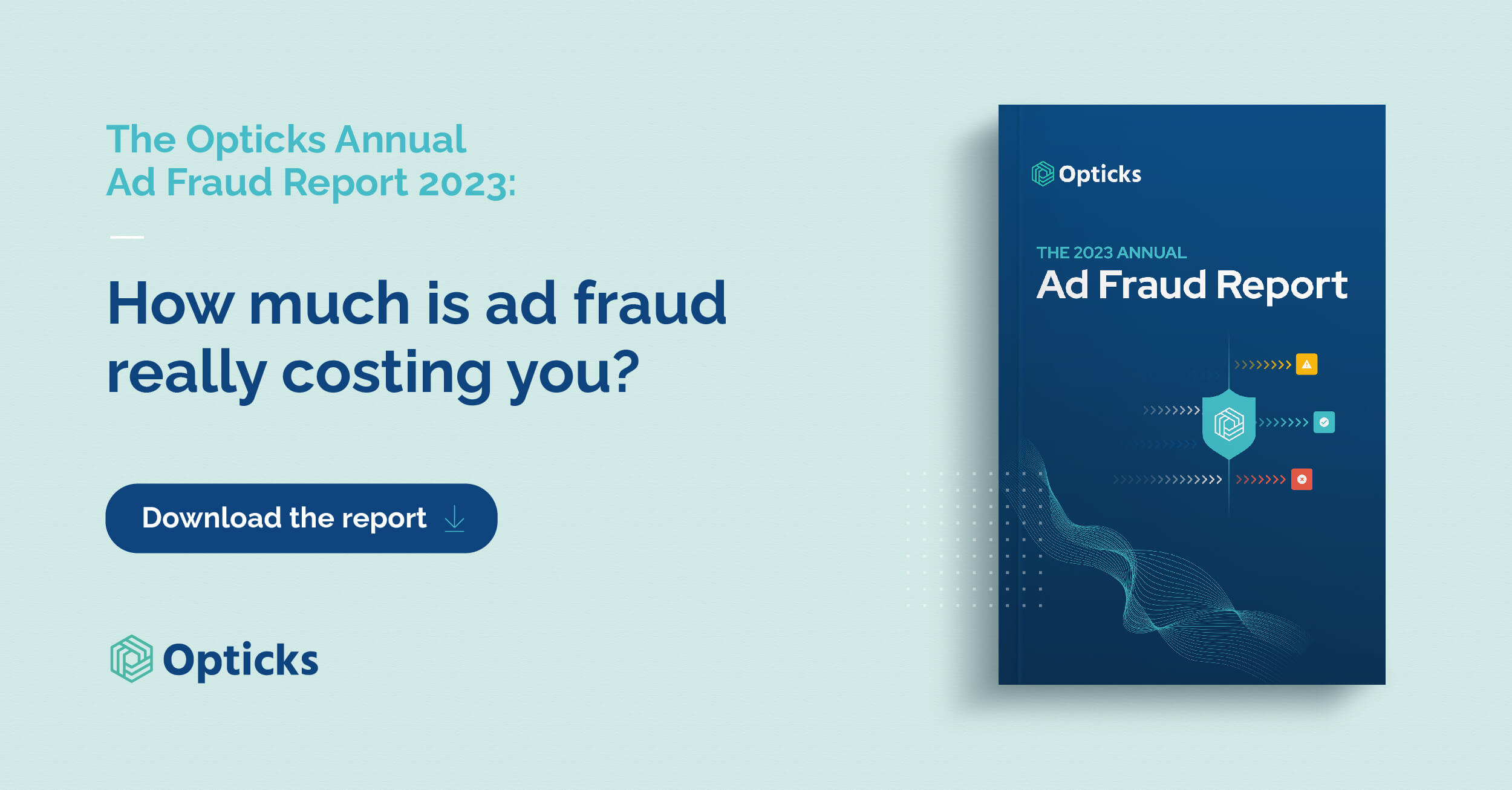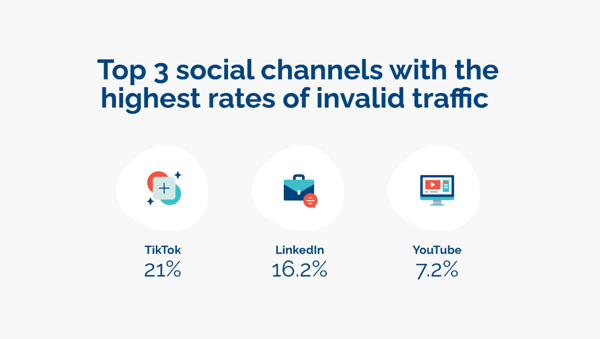Ad Fraud Report 2023 Summary: Key Findings

 By
Eduardo Aznar
·
4 minute read
By
Eduardo Aznar
·
4 minute read
Last year, ad fraud was reported to cost advertisers $81 billion in losses. Now, in 2023, this figure is predicted to increase by 25% to a colossal $100 billion. Coupled with the fact that global digital ad spending is expected to surpass $626 billion in 2023, you’d expect advertisers to be on high alert to prevent fraudsters’ tricks.
Yet, our research revealed that almost 7 out of 10 advertisers claim to not have experienced ad fraud at all -- although the majority admit that they don’t actually have solutions to measure it.
The Opticks 2023 Annual Ad Fraud Report (based on an analysis of 4.7 billion clicks across 245 territories) is a resource for advertising stakeholders globally to help you understand the true impact of ad fraud across channels, industries, continents, and countries, evaluate campaign risks, and safeguard your organization from ad fraud.
Ad fraud trends
We surveyed professionals in the advertising industry to learn about their top priorities and how their goals could be at odds with the ubiquity of ad fraud. The results show that most advertisers are still not conscious of how damaging ad fraud is.
- The majority of respondents said that improving ROAS is their key strategy -- but our research shows that organizations without any fraud prevention systems or processes in place can expect a reduction in ROAS of 11%
- Advertisers suspect that affiliate channels and native networks have the highest presence of ad fraud -- yet our data shows that affiliate and programmatic advertising are leading the ranks. On top of this, many respondents believe that ad fraud is not a threat to any advertising channel
- The increase in programmatic advertising has made it easier for fraudsters to exploit vulnerabilities in the system, leading to an increase in the total cost of ad fraud
We analyzed the ad fraud rates across nine industries and shared the ad fraud types and techniques used in each.
Ad fraud by industry
We analyzed the ad fraud rates across nine industries and shared the ad fraud types and techniques used in each.
- The telecom industry suffers from the worst rate of ad fraud. Fraudsters employ sophisticated bots and geo-masking techniques to exploit the telecom industry's high payouts, resulting in fake leads and customer complaints
- The software industry follows closely behind. Advertisers in the software sector encounter a wide range of fraud schemes, including login attempts, scrapers, and malware impersonation. Inefficient SEM budgets are also a concern, as users often click on paid links instead of direct or organic browsing
- Industries with seemingly lower ad fraud rates are not to be dismissed. Our data shows that the travel industry has the lowest fraud rate, yet as it generates a huge amount of online activity, fraud in the sector is diluted among millions of real clicks
- Similarly, in ecommerce, SEM and social channels are generally advertisers’ primary marketing focus. While these channels may also show lower fraud rates, competition for keywords leads to attacks from competitors, resulting in poor performance and wasted budgets
Ad fraud by region
One thing that hasn’t changed is that every country is vulnerable to ad fraud. However, the threat of ad fraud is not linear across regions, countries, and continents, and depending on where they are located, each region faces unique challenges that require tailored solutions.
To address the scale of the problem and find the right solutions, we analyzed data by type, continent, and country.
While our analysis provided many interesting insights -- including the fact that India jumped from 24th place in 2022 to first place, and the U.S. dropped from 17th to 2nd -- it’s clear from the complete data that all countries share the need for comprehensive ad fraud prevention measures to combat its potential damage.
Ad fraud by channel and a breakdown of social channels
Fraudsters target all types of advertising channels. Last year, the top three channels were affiliate, programmatic, and native -- and this remains the case in 2023.
However, since social media marketing is being utilized more than ever (with our survey revealing that most advertisers plan to invest the majority of their ad spend in social), advertisers will find particular value in our deep-dive into invalid traffic rates in social channels.

In terms of social media marketing and advertising, our data shows:
- TikTok, LinkedIn, and YouTube have the highest levels of invalid traffic
- Click fraud, often involving smartphone emulators, is a prevalent issue on TikTok, generating artificial views and clicks. While TikTok presents an attractive traffic source for advertisers, it lacks effective prevention measures against rampant click fraud
- The data underscores the fact that no platform is entirely immune to ad fraud, emphasizing the need for advertisers to invest in advanced anti-ad fraud measures to safeguard their budgets
Final words and predictions for 2023
The report demonstrates the omnipresence of ad fraud across all regions, channels, and industries. And, since advertisers are currently not prioritizing anti-fraud measures and the fact that fraudsters’ techniques continue to improve, we will see an increase in the complexity of invalid traffic.
Additionally, our research showed that the rise in AI chatbots -- such as ChatGPT -- is now helping fraudsters perform nefarious tactics with even more ease.
However, we predict that advertisers and ad fraud detection companies will work more closely together to prevent ad fraud by implementing a robust anti-ad fraud strategy. In particular, we will also see Tier 1 agencies and networks make ad fraud prevention a crucial strategy.
Ensuring protection against ad fraud requires a comprehensive approach. To effectively mitigate its risks, advertisers must not only adopt a professional anti-fraud solution but also consistently strengthen and evaluate their ad fraud prevention procedures in their entirety.
What else can you discover in the Opticks 2023 Ad Fraud Report?
Eager to discover the full insights in the Opticks 2023 Ad Fraud Report? Here’s what else is waiting for you in the full copy:
- Key insights from our Advertising & Ad Fraud Trends Survey
- An updated list of the top 10 countries affected by ad fraud worldwide
- The prevalence of ad fraud in specific marketing channels, continents, and industries
- New data on ad fraud rates in popular social channels
- A forecast of digital advertising spend in 2023, as well as a summary of ad fraud in 2023
- Expert ad fraud predictions for 2023
Click here to download the full report for access to the complete data and further insights.
